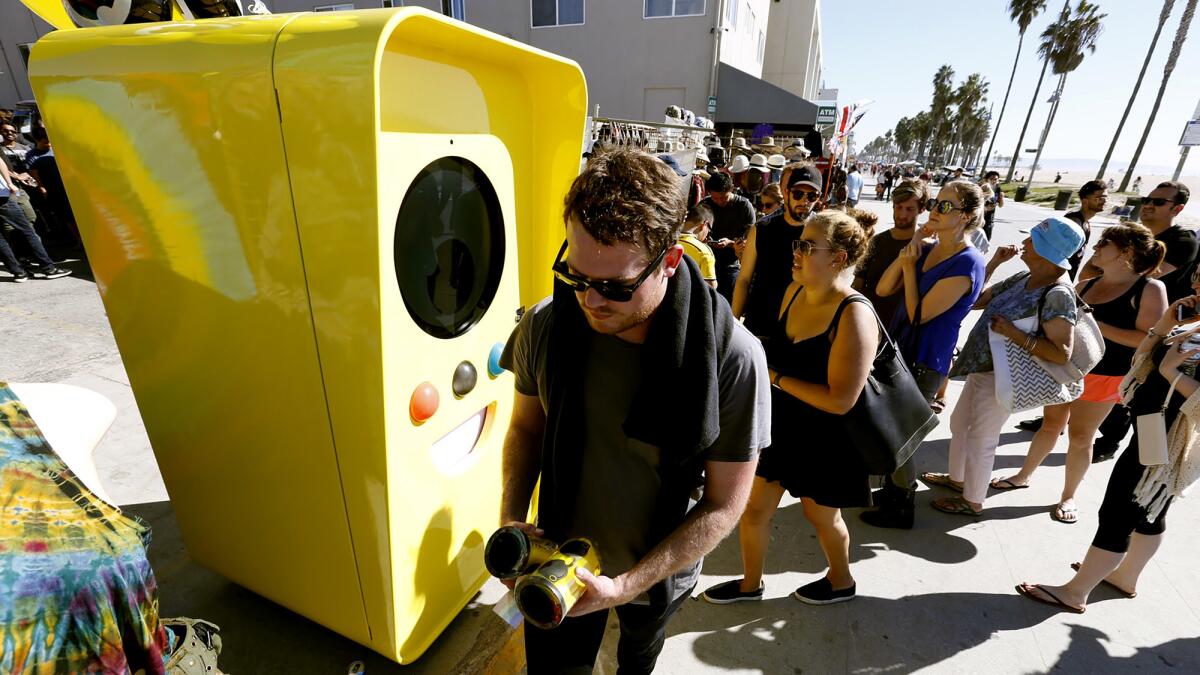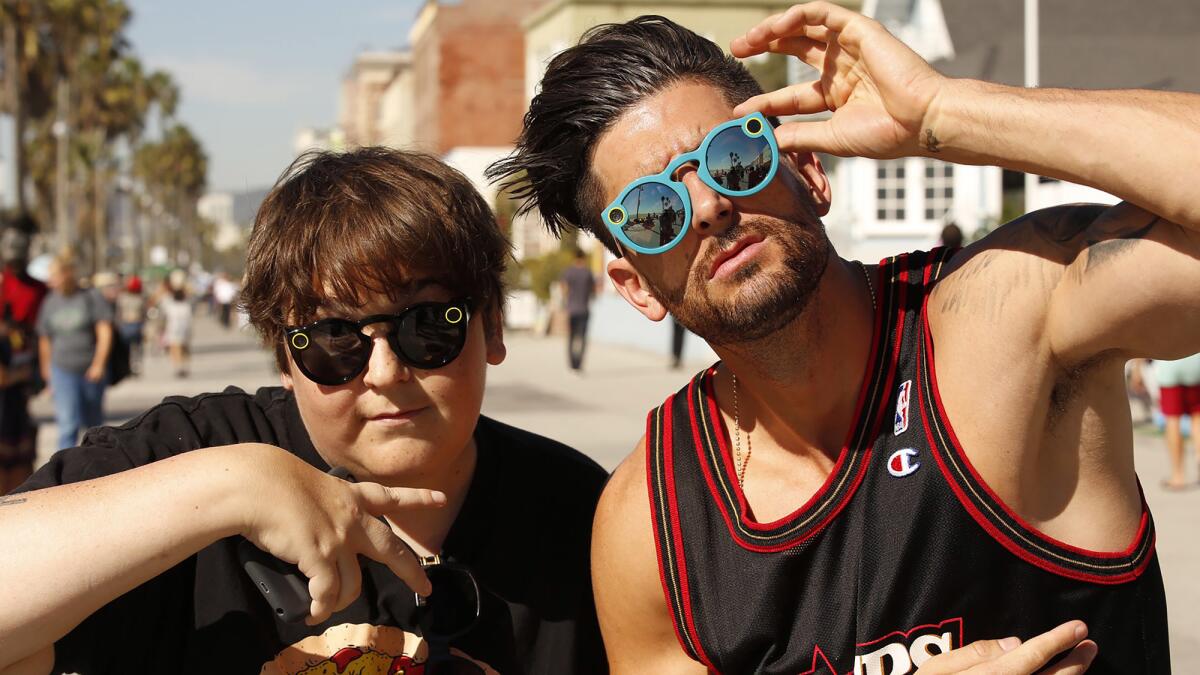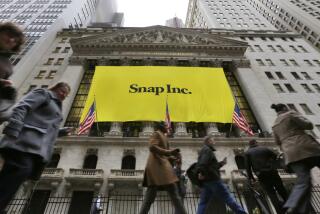Snapchat Spectacles, available only in pop-up vending machines, debut to long lines

When a tech company moved into a house next to her Venice Beach boardwalk sunglasses stand three years ago, Maria Shim had no idea that it would eventually become her competition.
But on Thursday, nearly all the demand for sunglasses on the boardwalk was centered 25 feet away from her table.
Hundreds of people lined up for hours to buy a pair of Snapchat Spectacles — available to the public for the first time and dispensed out of a bright yellow vending machine.
The quirky debut for the $130 video camera sunglasses drew worldwide attention. Snapchat developer Snap Inc. has amassed 150 million daily users of its image-sharing, chatting and news app. Spectacles are the Venice company’s first try at high-tech hardware.
Snap is expected to introduce more devices in the years to come as part of a broad strategy to change how people communicate. If the early vision for Spectacles is eventually realized, it will decrease people’s need to pull out their smartphones.
For now, tapping a button near the left hinge of the Spectacles activates a camera in the corner of the left lens. It takes circular-cropped videos of up to 30 seconds each. The clips can be transferred wirelessly to the Snapchat smartphone app, where they can shared with friends.
The company and analysts describe the coral, teal and black pairs that went on sale Thursday as toys. Head-worn devices, including Google Glass, have had limited consumer appeal, and the initial run of Spectacles may be a gimmick. But sunglasses are an untested format and Snapchat’s millennial users make a good starting ground, Gartner technology analyst Brian Blau said.
He questioned the sales strategy, though. Pop-up vending machines, each in the same location for only 24 hours in the months to come, are unlikely to attract Snapchat’s core audience of teenagers and college students.
Few people in line Thursday fit that description. Most were older, coming from the Los Angeles tech scene or media. Others hoped to fetch big profits by reselling the sunglasses for hundreds of dollars on EBay. The youngest said they were in line for their bosses.

Westside resident Darren Yan, 29, was among the hundreds of people able to purchase two sunglasses before supplies ran out at 2:45 p.m. Yan wanted to see whether he could hack the sunglasses to work with apps beside Snapchat, he said, describing it as research for the music technology company he works at.
His co-worker, Ally Guatno, 27, had a personal reason to buy Spectacles. She has exchanged 20,000 messages on Snapchat, and the sunglasses could produce more captivating videos.
They arrived around 10 a.m. after waking up to all-caps Facebook messages from friends demanding that they go buy a pair.
“If you’re wearing them you’re part of the cool kids club,” Guatno said. “You’re part of the clique.”
Snap employees teased the line sporting their own Spectacles, while others gawked from inside the big blue house where the company first opened up shop in Venice.
Advertising revenue remains Snap’s focus, but hardware designed for Snapchat could help maintain interest in the app. The company wants to go public next year at a projected value of upward of $25 billion.
Spectacles, like Snapchat itself, stem from a Stanford University project. Jon Rodriguez developed an early version of the product at the StartX accelerator at Stanford in 2012. Snap purchased his company in 2014.
Tony Lai, a mentor at the program, described Rodriguez as the product’s creative genius. Rodriguez was dead set on making the glasses aesthetically pleasing, Lai said. The initial models were cast on rudimentary 3-D printers with soldered-on wires still popping out. They were lightweight but a bit unwieldy.
“Fast forward, it’s phenomenal to see the early prototypes turn into a beautiful, beautiful product,” Lai said.
Jasmine Seng, a research associate at Euromonitor International who studies the $18-billion global sunglasses market, said the Chinese-made glasses probably are being sold near the production cost. In other words, Snap isn’t charging a premium.
The sunglasses aren’t polarized or waterproof. They can take about 100 videos before needing a recharge in a special carrying case. And they shouldn’t be used while driving.
Shim and other nearby Venice shop owners were frustrated by the vending machine’s presence Thursday. But the machine, which the company calls Snapbot, might not return for a while.
Like video stories on the Snapchat app that can be accessed for only 24 hours, a Spectacles vending machine will disappear from a spot after about a day, the company said.
People will be clued in to new locations through a map on Spectacles.com, geofilter stickers that will appear in the app and balloons on top of the vending machine. The vending machines are the only way to buy Spectacles directly from Snap, though retail sales could follow. A 30-day return policy applies, the company said.
Analysts say Spectacles aren’t a threat to traditional sunglasses. And that seemed to be proved true on the Venice boardwalk. Even Snap employees passing by with Spectacles still had traditional sunglasses draped on their collars.
Twitter: @peard33
ALSO
Column: Will Trump put stimulus spending back on Washington’s agenda?
Solar power proponents are hopeful Trump sees benefit of growing industry
After Trump’s win, even some in Silicon Valley wonder if Facebook has grown too influential
UPDATES:
4:20 p.m. This article was updated with additional quotes and details. It was originally published at 9:50 a.m.







